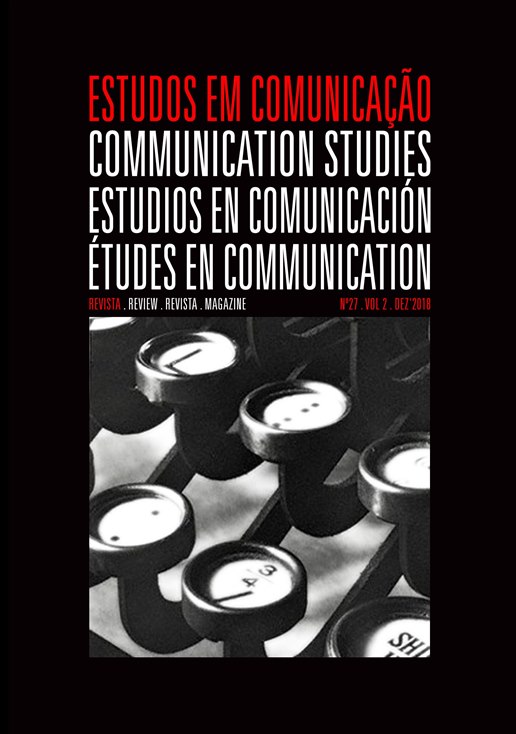Narrative games in ergodic media
Palavras-chave:
Computational Art, Ergodic Media, Artificial AestheticsResumo
Computational media allow the development of very particular relationships with readers. Their nature allows them to register static information but also complex and contingent behaviours that they are capable to operationalise, thus becoming interactive and immersive. These media exist in a dual state between a surface layer and a subface layer. These two are inextricably connected, with the subface often becoming a black box that can only be peered at through surface effusions that both mediate and isolate it. The procedural layer of the subface can be discovered through a process of virtuosic interpretation that allows readers to form a theory of system, breeding empathy with it, and ultimately, transferring some of its processes to their minds. This paper focuses on how virtuosic interpretation is developed, and how from it stems the development of a unique kind of aesthetic experience. It explores how computational media, through anamorphosis and a dialectics of aporia and epiphany, become narrative games.
Referências
Aarseth, E. J. (1997). Cybertext: Perspectives on Ergodic Literature. Baltimore, MD: The Johns Hopkins University Press.
Albert, S. (2009). Artware. In J. B. Slater & P. v. M. Broekman (eds.), Proud to Be Flesh: A Mute Magazine Anthology of Cultural Politics After the Net (pp. 89-92). London: Mute Publishing.
Alexander, C. (2002). The Nature of Order: An Essay on the Art of Building and the Nature of the Universe. Book Two: The Process of Creating Life. Berkeley, CA: The Center for Environmental Structure.
Ball, P. (2004). The Self-Made Tapestry: Pattern Formation in Nature. Oxford: Oxford University Press.
Berry, D. M. (2011). The Philosophy of Software: Code and Mediation in the Digital Age. Basingstoke: Palgrave Macmillan.
Blais, J., & Ippolito, J. (2006). At the Edge of Art. London: Thames & Hudson.
Boden, M. A. (2004). The Creative Mind: Myths and Mechanisms. (Second ed.). London: Routledge.
Bogost, I. (2006). Unit Operations: An Approach to Videogame Criticism. Cambridge, MA: The MIT Press.
Carvalhais, M. (2016). Artificial Aesthetics: Creative Practices in Computational Art and Design. Porto: U.Porto Edições.
Carvalhais, M. & Cardoso, P. (2015a). Beyond Vicarious Interactions: From Theory of Mind to Theories of Systems in Ergodic Artefacts. Paper presented at xCoAx 2015, Glasgow. http://2015.xcoax.org/pdf/xcoax2015-Carvalhais.pdf.
Carvalhais, M. & Cardoso, P. (2015b). What Then Happens When Interaction is Not Possible: The Virtuosic Interpretation of Ergodic Artefacts. Journal of Science and Technology of the Arts, 7(1): 55-62. doi: 10.7559/citarj.v7i1.144.
Carvalhais, M. & Cardoso, P. (2017). Creation of Meaning in Processor-based Artefacts. Paper presented at ISEA 2017, Bio-Creation and Peace, Manizales.
Cooper, A.; Reimann, R.; Cronin, D. & Noessel, C. (2014). About Face: The Essentials of Interaction Design, Fourth Edition. Indianapolis, IN: Wiley.
Dehaene, S. (2009). Reading in the Brain: The Science and Evolution of a Human Invention. New York, NY: Viking.
DeLanda, M. (1997). A Thousand Years of Nonlinear History. Brooklyn, NY: Zone Books.
Eagleman, D. M. (2011). Incognito: The Secret Lives of the Brain. New York, NY: Pantheon Books.
Galanter, P. (2003). What is Generative Art? Complexity theory as a context for art theory. Paper presented at the Generative Art, Milan. www.philipgalanter.com/downloads/ga2003_what_is_genart.pdf
Hayles, N. K. (2005). My Mother Was a Computer: Digital Subjects and Literary Texts. Chicago, IL: The University of Chicago Press.
Hunicke, R.; LeBlanc, M.&Zubek, R. (2004). MDA: A formal approach to game design and game research. Paper presented at the Challenges in Games AI Workshop, Nineteenth National Conference of Artificial Intelligence, San Jose, CA.
Kwastek, K. (2013). Aesthetics of Interaction in Digital Art (N. Warde, Trans.). Cambridge, MA: The MIT Press.
Lopes, D. M. (2010). A Philosophy of Computer Art. Oxon: Routledge.
Lorenz, E. N. (1995). The Essence of Chaos. Seattle, WA: University of Washington Press.
Mateas, M. (2005). Procedural Literacy: Educating the New Media Practicioner. On The Horizon. Special Issue: Future of Games, Simulations and Interactive Media in Learning Contexts, 13(1).
Metzinger, T. (2009). The Ego Tunnel: The Science of the Mind and the Myth of the Self. New York, NY: Basic Books.
Minsky, M. (1972). Computation: Finite and Infinite Machines. London: Prentice-Hall International.
Murray, J. H. (1997). Hamlet on the Holodeck: The Future of Narrative in Cyberspace. Cambridge, MA: The MIT Press.
Murray, J. H. (2003). Inventing the Medium. In N. Wardrip-Fruin & N. Montfort (eds.), The New Media Reader (pp. 3-11). Cambridge, MA: The MIT Press.
Murray, J. H. (2012). Inventing the Medium: Principles of Interaction Design as a Cultural Practice. Cambridge, MA: The MIT Press.
Murtaugh, M. (2008). Interaction. In M. Fuller (ed.), Software Studies: A Lexicon (pp. 143-149). Cambridge, MA: The MIT Press.
Nake, F. (2016). The Disappearing Masterpiece. In M. Verdicchio, A. Clifford, A. Rangel, & M. Carvalhais (eds.), xCoAx 2016: Proceedings of the fourth conference on Computation, Communication, Aesthetics, and X. (pp. 11-26). Bergamo.
Norman, D. A. (2007). The Design of Future Things. Philadelphia, PA: Basic Books.
Pinker, S. (1999). How the Mind Works. London: Penguin Books.
Queneau, R. (1961). Cent Mille Milliards de Poèmes. Paris: Gallimard.
Reas, C. E. B. (2005). Process 4.
Ramachandran, V. S. (2011). The Tell-Tale Brain: A Neuroscientist’s Quest for What Makes Us Human. New York, NY: W. W. Norton & Company.
Rucker, R. (2005). The Lifebox, the Seashell, and the Soul: What Gnarly Computation Taught Me About Ultimate Reality, the Meaning of Life, and How to Be Happy. New York, NY: Thunder’s Mouth Press.
Shermer, M. (2011). The Believing Brain: From Ghosts and Gods to Politics and Conspiracies – How We Construct Beliefs and Reinforce Them as Truths. New York, NY: Times Books.
Simon, J. F., Jr. (1997). Every Icon.
Strickland, S. (2007). Quantum Poetics: Six Thoughts. In E. Kac (ed.), Media Poetry: An International Anthology (pp. 25-44). Bristol: Intellect.
Thayer, P. (2009). Sleep.
Upton, B. (2015). The Aesthetic of Play. Cambridge, MA: The MIT Press.
Weizenbaum, J. (1976). Computer Power and Human Reason: From Judgment to Calculation. San Francisco, CA: W. H. Freeman and Company.
Zunshine, L. (2006). Why We Read Fiction: Theory of Mind and the Novel. Columbus, OH: Ohio State University Press.


